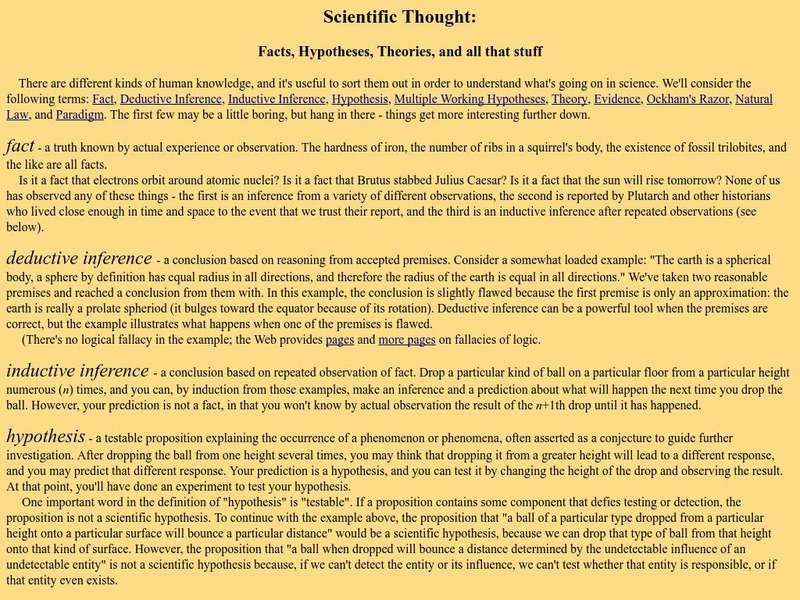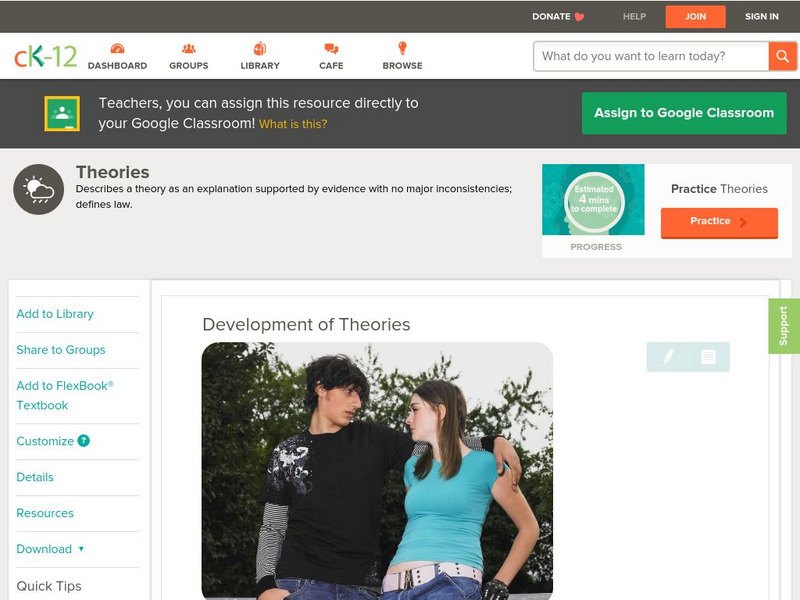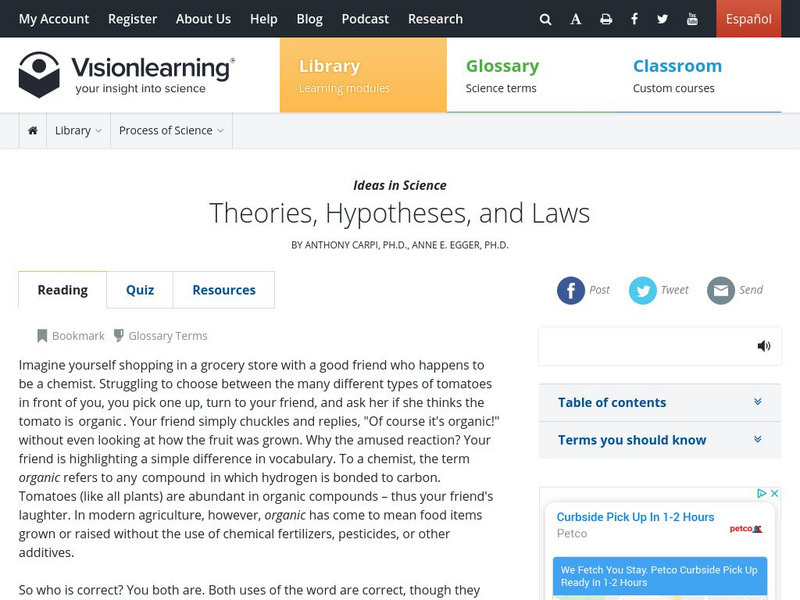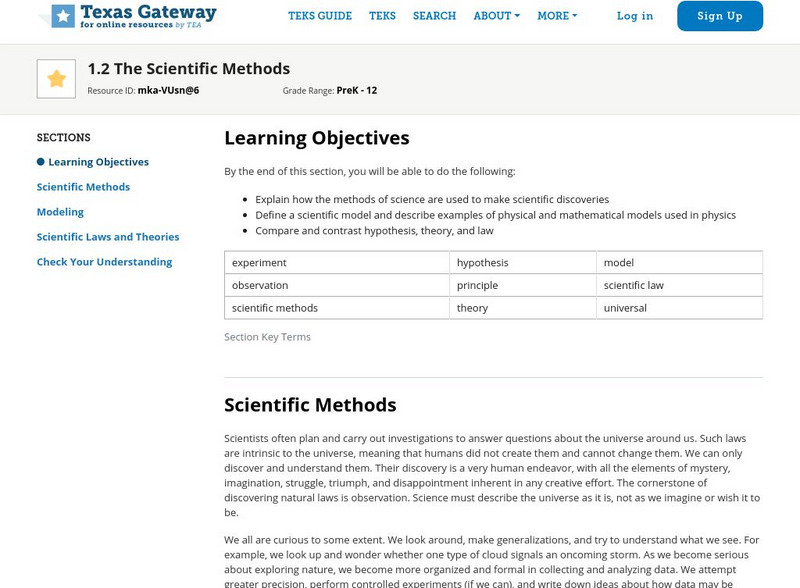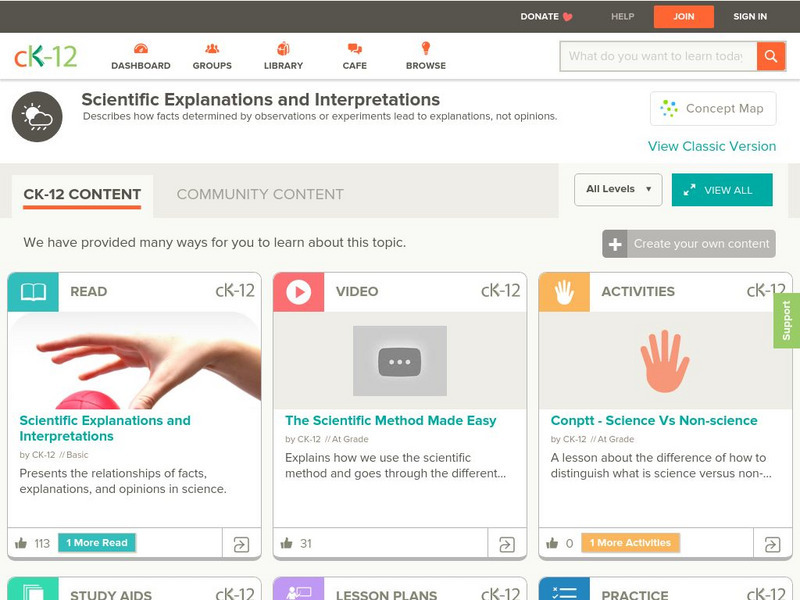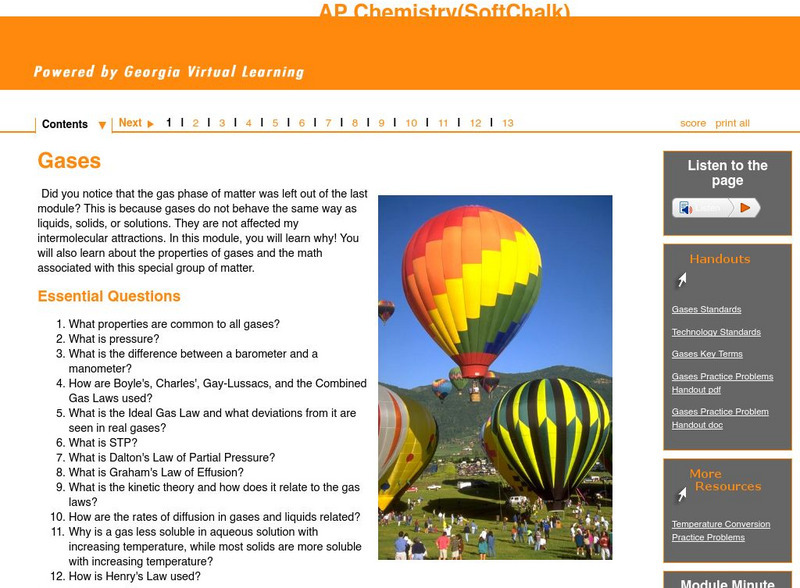University of Georgia
University of Georgia: Scientific Thought: Facts, Hypotheses, Theories, Etc.
Provides explanations of terms used in science: fact, deductive inference, inductive inference, hypothesis, multiple working hypotheses, theory, evidence, Ockham's Razor, natural law, and paradigm.
Georgia Department of Education
Ga Virtual Learning: Chemistry: Gas Laws
Through informational text, interactive practice problems, virtual simulations, and video clips, students learn about the gas laws.
Georgia Department of Education
Ga Virtual Learning: Ap Chemistry: Kinetics and Equilibrium
Through interactive activities in a module format, students learn about kinetics, collision theory, reaction rates, and rate laws. They will calculate rate laws from experimental data, concentration and time, and half-life of a reaction....
Khan Academy
Khan Academy: Dalton's Law of Partial Pressure
Use this tutorial to understand Dalton's Law of partial pressure, and then answer some interactive practice questions to review the material.
Texas Education Agency
Texas Gateway: Atomic and Molecular Explanation of Pressure and Temperature
Learn how to calculate the kinetic energy of a gas molecule, describe the relationship between the temperature of a gas and the kinetic energy of atoms and molecule, and describe the distribution of speeds of molecules in a gas. The...
CK-12 Foundation
Ck 12: Earth Science: Development of Theories
[Free Registration/Login may be required to access all resource tools.] Examines theories and laws in science.
CK-12 Foundation
Ck 12: Earth Science: Development of Theories
[Free Registration/Login may be required to access all resource tools.] Examines theories and laws in science.
CK-12 Foundation
Ck 12: Earth Science: Development of Theories
[Free Registration/Login may be required to access all resource tools.] Examines theories and laws in science.
CK-12 Foundation
Ck 12: Earth Science: Development of Theories
[Free Registration/Login may be required to access all resource tools.] Examines theories and laws in science.
Science Struck
Science Struck: What Is Gravity and How Does It Work
A very detailed look at gravitational force and the many theories that have been put forward to try to explain it. Includes lots of illustrations.
Vision Learning
Visionlearning: Ideas in Science: Theories, Hypotheses, and Laws
Learning module looking at scientific explanations. Discussion covers theories and how they develop, some well-known theories and their origins, and how theories are revised and refined. Also, covers hypotheses and laws. The three...
Khan Academy
Khan Academy: Dalton's Atomic Theory
Resource investigates the beliefs of Dalton's atomic theory which consists of four parts. Which points do we still use today, and what have we learned since Dalton?
Texas Education Agency
Texas Gateway: Physics: The Scientific Methods
By the end of this section, you will be able to explain how the methods of science are used to make scientific discoveries; define a scientific model and describe examples of physical and mathematical models used in physics; and compare...
CK-12 Foundation
Ck 12: Scientific Explanations and Interpretations
[Free Registration/Login may be required to access all resource tools.] Students learn about scientific explanations and interpretations through instructional videos, grade-level texts, interactive activities, and quick assessments.
CK-12 Foundation
Ck 12: Scientific Theories
[Free Registration/Login may be required to access all resource tools.] Students will understand the difference between theories, hypotheses, and laws in science.
Florida State University
Florida State University: Science, Optics & You: Sir Isaac Newton
Biography of Sir Isaac Newton (1642-1727), a scientist whose impact is felt in many disciplines today. His laws of motion are integral to basic physics, and he co-invented calculus.
Exploratorium
Exploratorium: Science Snacks: Magnetic Fruit: Push Me a Grape
An online activity which illustrates the magnetic property of diamagnetism associated with water. Contains a simple procedure and then a good explanation of the magnetic interactions that were displayed by the grapes.
Story Behind the Science
Story Behind the Science: Pendulum Motion, Time, and Shape of Earth [Pdf]
Article outlining the scientific history behind the evolution of theories about measuring time based on the movement of a pendulum, and about how gravity would impact a pendulum's movement depending on one's proximity to the Earth's...
Science Struck
Science Struck: A Comprehensive List of All the Physics Formulas
Provides a long list of physics formulas for easy reference.
CK-12 Foundation
Ck 12: Physical Science: Scientific Theory
[Free Registration/Login may be required to access all resource tools.] Nature of scientific theories, examples of physical science theories, and the law of parsimony.
Khan Academy
Khan Academy: What Is the Ideal Gas Law?
Learn how pressure, volume, temperature, and the amount of a gas are related to each other.
Khan Academy
Khan Academy: Calculations Using the Ideal Gas Equation
Practice calculating pressure, volume, temperature, and moles of gas using the ideal gas equation.
Khan Academy
Khan Academy: Non Ideal Behavior of Gases
Find out how real gases differ from ideal gases, and when intermolecular attractions and gas molecule volume matter.
Georgia Department of Education
Ga Virtual Learning: Ap Chemistry: Gases
In this module, you will learn why gases are not affected by intermolecular attractions! You will also learn about the properties of gases and the math associated with this special group of matter.
